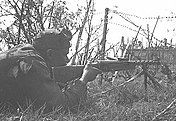User:BaronNishi/sandbox
| Third Balkan War | |||||||
|---|---|---|---|---|---|---|---|
| Part of Mediterranean and Balkans theater of World War II and the Balkan Wars | |||||||
From the top, left to right: Turkish anti-aircraft crew atop the Hagia Sophia in Istanbul, September 1941; Bulgarian soldier near Edirne, December 1941; Hitler greeting Boris III, 1941; İnönü, Roosevelt, and Churchill at the Second Cairo Conference, December 1943; Two fallschirmjägers sharing a cigarette at the K-K line, May 1942; Royal Marines on the island of Lesbos, October 1942 | |||||||
| |||||||
| Belligerents | |||||||
|
Axis:
| ||||||
| Commanders and leaders | |||||||
The Third Balkan War was a transcontinental conflict between Turkey and the Allies against Bulgaria and the Axis in one of the bloodiest of the Balkan Wars fought until the 1990s. The conflict pitted Turkey and the Allies against Bulgaria and the Axis in the final culmination of the Balkan Wars that included the two countries as part of World War II itself.
Prelude
[edit]As part of Mustafa Kemal Atatürk's slogan for peace, Turkey sought for neutrality and a balanced relationship with the Allies and Axis powers upon the eruption of World War II in September 1939, which was respected until the sinking of a Turkish cargo streamer by an Italian submarine in June 1941 carrying officers from Mersin to Port Said in Egypt to join a British mission heading to London.
The violation of neutrality would spark universal outrage among the Turkish populace, and on July 29th of the same year with the unanimous support off the Grand National Assembly, Turkey would declare war on Italy and Germany, which was subsequently be reciprocated by the Axis with the notable exclusion of Japan the following day.
Thracian Front
[edit]Due to the Turkish ability to shut the Dardanelles per the Montreux Convention and Allied maritime dominance in the eastern Mediterranean, naval operations surrounding Aegean would be in a smaller scope than present in the other theaters of operation during the war; in the Black Sea however, Turkish naval forces would fight against Bulgarian and Romanian vessels on equal footing. In part of this, Bulgarian officials would meet with their Italian and German counterparts in August in Sofia to strategize a way to break into Istanbul and into Anatolia in order to force an immediate surrender of Turkey.
The first Bulgarian offensive into Turkey with German and Italian support, codenamed Operation Asparuh, centered itself on the capture of Edirne, Kırklareli, and Keşan to guarantee the occupation of Istanbul in by winter 1941. Although gaining ground and inflicting severe losses on Turkish forces, the initiative would be broken in June 1942 following an series of attrition warfare conducted by both regular Turkish soldiers and Greek partisan units at the K-K line, a 200 km (124 mi) string of fortifications and obstacles stretching from Kavakköy to Kıyıköy with the arrival of Commonwealth support at the doorsteps of Istanbul.
Subsequently, landings in the Italian-occupied Dodecanese islands would culminate in the fall of Leros and Kos in October, Lesbos in November, and Samos in December, though Rhodes, the largest of the Dodecanese and one of the core targets for the operations, was deliberately bypassed by the Allies, opting for a virtual blockade of the island until the end of the war. Following the Armistice of Cassibile that knocked Italy out of the war in September 1943, the major focus would be towards Western and Northern Thrace for the Allies; the cities of Thessaloniki and Plovdiv were labelled as key objectives following the Second Cairo Conference.
1944 would open with a joint German-Bulgarian offensive alongside with Romanian participation.
Aegean Front and the liberation of Crete
[edit]Through intelligence reports conducted by SOE, OSS, and resistance members via aerial surveys and radio, the island of Crete, lost to the Germans in May 1941 found itself amassed in atrocities committed against civilians by the local German garrison, prompting an airborne invasion of the island by Commonwealth and Greek forces in conventional paratrooper aircraft and tow planes with American naval support in September 1943. After a two-month battle with severe losses on both sides, the German garrison would surrender despite Hitler's demand for the island to fight to the last.
- Aircraft of the Third Balkan War
-
Turkish PZL P.24s in a hanger undergoing maintenance in Istanbul, December 1941
-
Turkish Curtiss-Wright CW-22 used for training aviators at a airfield in Ankara, January 1943
-
Gliders like the Airspeed Horsa was used to support airborne operations on the Aegean and Dodecanese islands










